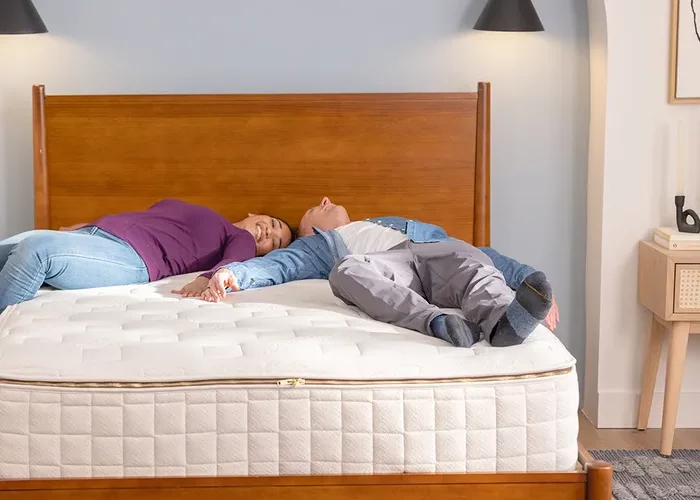
Discover how hybrid sleep schedules can help you reclaim rest.
If your nights no longer fit the classic “8-hour block,” you’re not alone. As I moved through perimenopause into menopause, my sleep naturally shifted into segments—a first stretch, a wakeful window, then a second sleep before morning. At first, I thought something was wrong, but I later learned this rhythm has a name: hybrid sleep. Blending tradition, science, and intuition, hybrid sleep may be the key to finding rest when your nights feel disrupted.
Hybrid Sleep Schedules: Finding a Rhythm That Actually Works for You
As I moved through perimenopause into menopause, my sleep shifted in ways I didn’t expect. Instead of eight straight hours, my nights unfolded in pieces—an early stretch, a wakeful window in the quiet middle of the night, and then a second sleep before morning. At first, I fought it, convinced something was wrong. But when I stopped resisting and leaned into the rhythm, I realized I was still getting my full rest, just in a different shape.
Later, I discovered this has a name: hybrid sleep. And it turns out, my body may have figured it out on its own.
What Is Hybrid Sleep?
Hybrid sleep blends elements of monophasic sleep (one continuous stretch) with biphasic sleep (two distinct periods). Instead of chasing the “classic” 8-hour block, hybrid sleep allows rest to unfold in segments—often a longer stretch at night, followed by a wakeful window, and then another shorter sleep. Some versions also include planned daytime naps.
For many of us, this isn’t just practical—it feels intuitive, especially during big life transitions like menopause.
A Pattern Rooted in History
Before electricity and the rigid 9-to-5 schedule, segmented sleep was not just common—it was the norm. People would ease into a “first sleep” a few hours after dusk, then wake in the middle of the night for one to three hours before slipping back into a “second sleep” until dawn.
That wakeful window wasn’t wasted time. Historical diaries, court records, and even medical texts describe people using those hours to pray, read, journal, tend the fire, check on livestock, or quietly talk with family. Some accounts even suggest it was considered the best time for intimacy—when bodies were rested but the world was still hushed.
Historian Roger Ekirch, who spent decades combing through archives, uncovered more than 500 references to this pattern in literature from Homer to Chaucer to early modern England. The phrases “first sleep” and “second sleep” appeared so often that people of the time clearly considered them ordinary.
But segmented sleep wasn’t universal. Anthropologists studying communities near the equator—where daylight and darkness are more balanced—found a tendency toward one main sleep period, sometimes with a nap during the heat of the day. This shows that human sleep is flexible and adapts to environment, season, and lifestyle.
In other words: what we now call “hybrid sleep” isn’t new, experimental, or broken. It’s a rhythm that’s been with us for centuries, only reshaped by artificial light and modern schedules.
Science Backs It Up
Modern sleep research shows that our bodies aren’t locked into one rigid pattern. Instead, sleep responds to light exposure, hormones, and daily rhythm.
In the 1990s, psychiatrist Thomas Wehr ran a landmark experiment where participants spent 14 hours a day in darkness for several weeks. At first, they slept longer than usual—catching up on accumulated sleep debt. But eventually their sleep stabilized into a biphasic rhythm: about 4 hours of “first sleep,” a calm wakeful period, and then another 4 hours of “second sleep.”
During that wakeful window, researchers found spikes in prolactin (a hormone linked to relaxation) and shifts in melatonin release, suggesting the body was entering a natural state of quiet restfulness—not insomnia. Some scientists believe this “watchful rest” was once an evolutionary advantage, allowing humans to tend fires, protect the group, or simply reflect in the middle of the night without feeling distressed.
Today, most of us consolidate our sleep into one block because of artificial light, work schedules, and social demands. Exposure to bright light at night suppresses melatonin, pushes bedtimes later, and shortens natural wakeful windows. But when people are removed from those modern cues—whether in a lab or in communities without electricity—segmented or hybrid sleep often re-emerges.
Neuroscientists also note that sleep architecture (the cycling through REM and deep sleep) can remain intact whether sleep is continuous or segmented, as long as the total hours are sufficient. In fact, some studies suggest that shorter stretches of sleep with wakeful intervals may increase recall of dreams and improve creative problem-solving.
The key takeaway? Hybrid sleep isn’t a flaw or a productivity gimmick—it’s one of several ways the human body is wired to rest, shaped by hormones, light, and environment.
Modern Hybrid Sleep Styles
Here are a few ways hybrid sleep shows up today:
🌙 Core Sleep + Nap
- 6–7 hours at night
- 20–90 minute nap midday
- Works well for siesta cultures or anyone who hits an afternoon slump.
Best around 1–3 p.m., when your body naturally dips.
🌙 Split Night Sleep (my personal style!)
- First sleep: 3–4 hours early at night
- Wakeful window: 1–2 quiet hours
- Second sleep: 3–4 hours before dawn
- Mirrors historical “first” and “second” sleep.
Use the wakeful window for calm activities—journaling, meditation, reflection. Avoid bright screens.
🌙 Anchor Sleep + Flex Nap
- 4–5 hours of “anchor sleep” at night
- Naps: one or two totaling ~3 hours during the day
- Helpful for caregivers, shift workers, or unpredictable schedules.
Keeping the anchor consistent helps stabilize your circadian rhythm.
🌙 Creative Hybrid
- 5–6 hours at night
- 60–90 minute midday nap
- Popular with night owls and creatives who get late-night inspiration.
Follow the nap with movement—a short walk—to shake off grogginess.
When Hybrid Sleep Helps
| When It Helps | When It Backfires |
|---|---|
| Total sleep: 7–9 hours | Naps too late in the day |
| Consistent rhythm | Total sleep dips below needs |
| Aligns with natural body cues | Treated like a “hack” instead of listening to signals |
My Takeaway
For me, menopause didn’t just change my hormones; it changed my nights. What looked like a disruption became an invitation to rest differently. Hybrid sleep gave me permission to stop fighting those wakeful hours and see them as part of the cycle.
If your nights are shifting—whether from emotional stress, family pressures, aging, or a new season of life—it doesn’t mean you’re falling apart. It might just mean your body is asking for a new sleep rhythm. The most important part isn’t the shape of your sleep…it’s that you wake up rested, restored, and ready for the day.
MORE SLEEP TIPS:
-
Sagittarius and the Cell Salt Silicea
Sleep Examiner Rating:
-
How to Hack Your Sleep: 12 Ways to Sleep Better
Sleep Examiner Rating:
-
Back Science Series 2 vs. Casper Snow Hybrid Mattress Comparison
Sleep Examiner Rating:
-
The Truth About Latex Mattresses
Sleep Examiner Rating:
-
Discover the Best 100% Latex-Free Mattresses
Sleep Examiner Rating:






